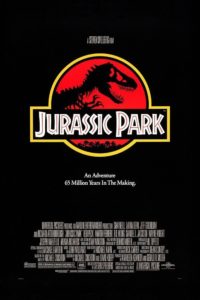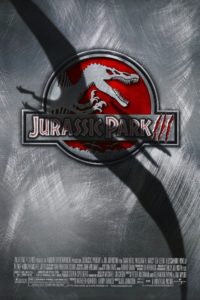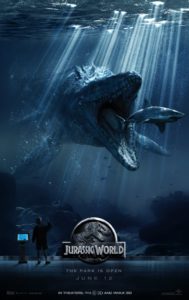All stories share the same literary elements, be they written or acted, books or movies.
Summer Blockbusters For the Win
And movies are a terrific means of illustrating all of those literary elements! Whether you yourself want to understand them better, want to have stimulating discussions with your kids, or want to teach your high school English class, movies should be on your list of resources. Period dramas (like Pride and Prejudice) are great studies in characterization. Fantasy and sci-fi movies (like Star Wars) can be fun studies in heroic journeys. But even summer blockbusters deliver in spades. Let me demonstrate a few literary elements with the Jurassic Park movies.*
*These movies are PG-13 for a reason. I use these movies because they are familiar in concept and storyline, even if you haven’t seen them. Preview before showing to children younger than 13.
 Foreshadowing
Foreshadowing
One of the easiest to discern in movies, particularly in suspenseful ones, foreshadowing jumps out in background music (Jaws, anyone?), dialogue (“life has a way of breaking free”–Jurassic Park), background scenery or images (power lines down, fences broken, etc.–in all of the Jurassic movies), and countless other mechanisms. The Jurassic movies are goldmines of foreshadowing techniques. Try watching the first one again (it’s on Netflix) with this in mind.
Mood
Kids can have a hard time identifying what contributes to mood in a text, but show them a movie with plenty of suspenseful scenes, thoughtful cinematography, and aesthetic detail, and suddenly, “mood” is front and center. Something like Schindler’s List or other war movies are good examples here. In Jurassic World, the boys are in the “hamster ball” and the movie watcher suddenly sees the Indomitus Rex through the window behind them. Suspense? check.
Prime the pump, if you want, and tell them to be looking and listening for things that seem suspenseful (puddles vibrating before the dinosaur shows up, background music, blood dripping from trees–too many examples to count!). Older movies are amazing examples of this, too, because they couldn’t depend on as many special effects. Alfred Hitchcock was a master at subtly creating suspense.
 Characterization
Characterization
Admittedly, most summer blockbuster hits are long on special effects and short on characterization. But we’re just introducing the concept. In the Jurassic movies, notice which people are careless with genetic manipulation versus those who respect life, who is careful and who is careless, who puts the good of humanity first and who is concerned about profit, …. How do their clothes, their words, their actions all help us know what sort of people they are–even before we see the whole movie? Do any characters change or grow during the movie?
Theme
Notoriously hard to pin down, theme can be elusive. A proper theme is a universal statement (not just one word) that the movie illustrates. There can be more than one theme in a story! But there should be evidence to back up each theme. The Jurassic movies scream, “We should be good stewards of creation.” Put another way, “Don’t manipulate life” or “Don’t use nature for your own ends.” Or, taking it a different direction, “Pride goes before a fall.”
 Plot
Plot
Exposition is the opening scene: what do we already know about the main characters? What is the essential “problem”? A careful archeologist contrasted with someone gleefully discussing their latest genetic victory sets it up nicely. Rising action includes the events leading up to the climax. A dinosaur breaking out of an enclosure, power failures, a dinosaur tearing out its tracking device, and kids in danger are all classic examples of rising action. The climax is the turning point, and it’s usually near the end. From this point on, the ending is set firmly in motion. Ask your kids what they think the most exciting part is, what the turning point is. In Jurassic World, when the raptors switch allegiance back to Owen, it’s a turning point. And, of course, the resolution is how it all wraps up.
This is enough to get you started! Don’t try to discuss every element with every movie. Just choose the ones that stand out the most strongly. (Warning: this can mean lots of pausing the movie to discuss and ask questions, and you might turn the kids into literary nerds accidentally as they enjoy pointing out all the signs! You can also talk about these elements after the movie is over.)
What movies have you seen that have good examples of literary elements? Try this with your kids and let us know how it works!
all images from imdb.com
Stay Up to Date!
Get the information you need to make wise choices about books for your children and teens.
Our weekly newsletter includes our latest reviews, related links from around the web, a featured book list, book trivia, and more. We never sell your information. You may unsubscribe at any time.
Support our writers and help keep Redeemed Reader ad-free by joining the Redeemed Reader Fellowship.
Stay Up to Date!
Get the information you need to make wise choices about books for your children and teens.
Our weekly newsletter includes our latest reviews, related links from around the web, a featured book list, book trivia, and more. We never sell your information. You may unsubscribe at any time.
We'd love to hear from you!
Our comments are now limited to our members (both Silver and Golden Key). Members, you just need to log in with your normal log-in credentials!
Not a member yet? You can join the Silver Key ($2.99/month) for a free 2-week trial. Cancel at any time. Find out more about membership here.


 Foreshadowing
Foreshadowing Characterization
Characterization Plot
Plot